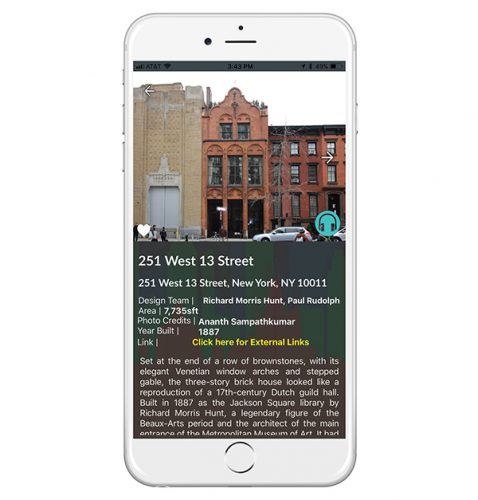By Mary Chandrahasan and Ananth Sampathkumar

One bright sunny morning in March, we headed out for an early morning stroll in the Village equipped with our latest virtual toy called LABYL (or Learn About Buildings you Love). We set out to find and share under-appreciated architectural constructs both old and new. LABYL is a free iPhone app that allows architecture enthusiasts to learn more about the built environment in New York simply by taking a photo. Inspired by the Shazam app for music, LABYL is an attempt to make New York’s architecture accessible to all. As two young architects in New York, we have always enjoyed learning the history and context of buildings we work on and our experience convinced us of a pressing need for an architectural app that allows users to identify buildings easily and on the go.
Our story goes back to 2001 when Mary came to the Big Apple to study architecture. Many years later, having paid our dues working in various architectural offices, we decided to set up our own studio called NDNY or New Delhi | New York. Our practice is pursuing transcontinental aspirations. Since our inception in 2012, we have dabbled in architectural and interior design projects, product design and now a mobile application—LABYL.
Here is a sampling of buildings we identified and learned about with LABYL during our stroll through the West Village:
Our first stop was Editions de Parfums Fredric Malle at 94 Greenwich Avenue. Fredric Malle’s first outpost in the Village designed by Steven Holl Architects. The site used to house the Bee Deserts and Café, a homey Brazilian bakery and dining spot that occupied the ground floor and garden behind. The store suffered the same fate as many other mom and pop shops in the Village. The space sat empty for a few years before the perfume shop came along. The renovated façade includes segmented curves that glow with the warm tones of custom crafted black walnut. The architect describes the forms as being inspired by “an imagined geometry for olfaction.” The material palette is rich, the vibe is zen-like and the space comes with a backyard to boot. None of this seems to be helping the foot fall but the Village can boast of one more high profile retail and architectural addition.
Our next stop was 251 West 13th street, a red brick clad Neo-Gothic building that used to be the Jackson Square branch of the New York Public Library. Designed by Richard Morris Hunt (of the Great Hall of Metropolitan Museum of Art fame) the structure was completed in 1887 and was a gift from George Vanderbilt. The Landmark Preservation Commission’s designation report for Greenwich Village Historic District describes it as “a charming reproduction of a Dutch guildhall of an early period, retaining traces of the Gothic, as seen in the trefoils of the blind arches above the windows.” The building was converted to residential in 1967 and renovated (some say butchered) by none other than Paul Rudolph, the modernist architect of Yale fame. Nancy Hass’ article titled A Strange House and Its Strange Story is a must read on this house’s storied past. The building stands out from its residential neighbors not only for the setback entry but also for the arched roofline and tall stature. So much history in one house!
Our walk ended at the Bus Stop Café on Hudson and Bethune. This West Village staple was the perfect place to relax, soak in the neighborhood and continue our architectural discourse over eggs and coffee.




[…] West Village Through the Lens of LABYL […]